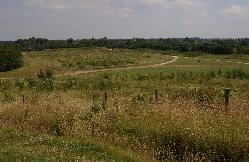 Background
Background
Areas of brownfield land are often contaminated from their former uses. The regeneration of brownfield land to green infrastructure can reduce the human and environmental health risks associated with these areas, and can also help to improve the local environment. Due to the potential risks, English planning law requires that contaminated sites must be remediated prior to redevelopment and remediation must ensure that the site is ‘suitable for use’. The use of greenspace and woodlands has been proposed as a cost-effective remedial strategy for the redevelopment of contaminated brownfield land.
Opportunities
Woodland establishment on brownfield land provides many social and environmental benefits and has long been a priority of forestry strategies in the UK. Trees have the potential to remove and immobilise contaminants through the processes of phytoremediation and phytostabilisation, and these processes are an inexpensive in situ approach to remediation. The establishment of vegetation on contaminated brownfield land can break the pollutant linkage pathways, for example through prevention of soil erosion which minimises dust production and reduces the risk to humans.
Regeneration of brownfield land provides indirect health benefits linked to use of the green space for exercise, general fitness and improved well-being. The provision of nearby green space also helps to encourage sustainable patterns of travel, such as cycling, which can reduce the prevalence of obesity and cardiovascular diseases.
Regeneration of brownfield land can improve the condition of the soil, vegetation, surface waters, including culverts, sustainable urban drainage systems and ditches and groundwater.
Also, as many brownfield sites across the UK consist of low-demand and abandoned housing, redevelopment provides an opportunity to improve and increase the supply of new, energy efficient homes. The Government’s Sustainable Communities plan of 2003 set a target for 60% of new housing to be constructed on brownfield land by 2020.
Practical considerations
For sites to be redeveloped it is necessary to first carrying out site investigation and to evaluate a shortlist of potential sites using British Standards Codes of Practice. The abundance of soil, its fertility and potential to sustain vegetation, and the consequences of tree and plant growth are first determined prior to regeneration.
Funding restoration can be an issue in brownfield regeneration, and land is more likely to be restored to green space if it is part of a larger programme. In addition, funding is required for the ongoing maintenance to ensure the environmental benefits to air, land and water continue into the long-term once the greenspace is created.
Sites that contain insufficient volumes of contaminated soil to justify setting up and using on-site decontamination technologies often lead to decontamination by landfill disposal. Such sites may represent a majority for many local authorities throughout the UK. On their own, the sites pose problems for remediation, but can be clustered together to offer economical treatment of materials at a central, shared ‘hub’.
Case study
The CMF woodland programme helped to develop 1,300 ha of community woodland, 40% on brownfield land. The programme benefited from £9 million of CMF funding with £4 million secured from other sources, including over £2.7 million support from the Northwest Development Agency. The programme involved local people in the regeneration of damaged and underutilised land in Greater Manchester, Cheshire and Merseyside in the Northwest and around the ‘gateway’ of the M25 corridor, north of the Thames Estuary, in the South East.
Further case studies
- Regeneration of previously developed land. Bold Colliery community woodland(PDF-85K).
- Regeneration of previously developed land. Creating community forestry in Glan Morfa, Rhyl, North Wales(PDF-1230K).
- Restoration of previously developed land. The Greenwich Peninsula: contamination remediation(PDF-82K).
- Regeneration of previously developed land. London Olympic Park: improving environmental and human health benefits through brownfield land regeneration to green space(PDF-2690K).
Services
Forest Research has developed Methuselah: A Monitoring and evaluation strategy for Greenspace (PDF-870K) in order to ensure that redevelopment on brownfield land plays a key role in meeting the UK’s Sustainable Communities Agenda.
Prove it! was developed by NEF (New Economics Foundation) in partnership with Groundwork UK and Barclays PLC to provide a method for measuring the effects of community regeneration projects on the quality of life of local people.
Further information
- Greenspace establishment on brownfield land: the site selection and investigation process (PDF-1006K). Forest Research, Farnham.
- Benefits of green infrastructure. Report by Forest Research(PDF-2300K). Forest Research, Farnham.
- Benefits of green infrastructure. Report to Defra and CLG(PDF-1180K). Forest Research, Farnham.
- Regeneration of previously developed land(PDF-45K). Benefits of green infrastructure evidence note. Forest Research, Farnham.
- The opportunities for woodland on contaminated land. Forest Research Information Note, Farnham.
